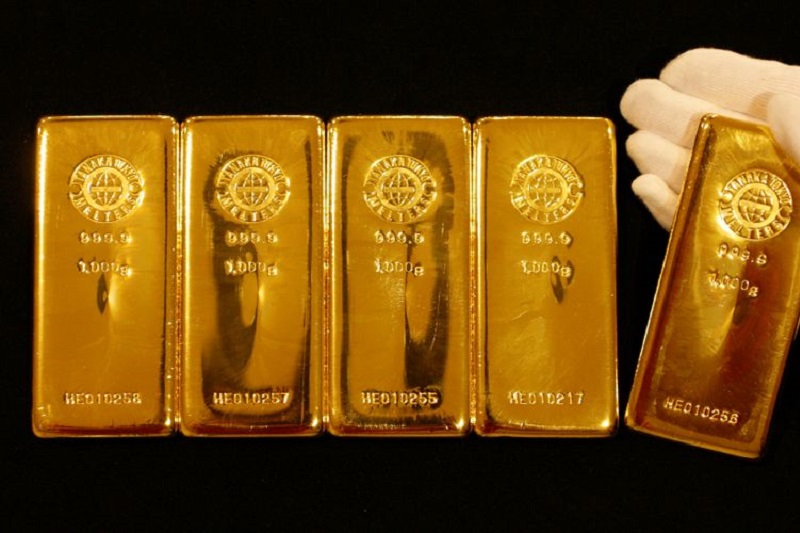* Fed's Powell says "long way to go" for economy to recover
* Platinum market in deficit this year and next- WPIC
* Interactive graphic tracking global spread of coronavirus:
https://tmsnrt.rs/3mvcUoa
(Adds comments, updates prices)
By Eileen Soreng
Nov 18 (Reuters) - Gold inched up and moved in a narrow
range on Wednesday, as investors weighed the prospects of a
COVID-19 vaccine against concerns over rising cases and the
possibility of further economic support from the U.S. Federal
Reserve.
Spot gold XAU= rose 0.1% to $1,880.81 per ounce by 0707
GMT, while U.S. gold futures GCv1 were down 0.4% at $1,878.30.
Gold shed as much as 1.3% on Monday after Moderna MRNA.O
said its vaccine was 94.5% effective in a late-stage trial.
"There's a lack of catalyst for gold to rally ... Weighing
on prices is a slight depression in inflation expectations
because it's quite clear now that the U.S. fiscal stimulus will
probably not be as sizeable as previously imagined," said IG
Markets analyst Kyle Rodda.
The emphasis is now on the Fed to support the U.S. economy
through the surge in coronavirus cases, he added.
Fed chair Jerome Powell said on Tuesday there's "a long way
to go" for the economy to recover and that the central bank is
committed to using all its tools to support the recovery.
Meanwhile, data showed U.S. retail sales rose less than
expected in October. "Gold has clearly run out of upward momentum, with the
short-term market clearly long," said Jeffrey Halley, senior
market analyst at OANDA, adding, a daily close below key support
around the $1,867 level could signal a deeper correction.
"I expect monetary policy globally, and especially from the
Fed to be ultra-easy right through 2021."
Gold, considered a hedge against inflation and currency
debasement, has gained over 24% this year, mainly benefiting
from massive global stimulus.
Silver XAG= rose 0.1% to $24.48 per ounce and palladium
XPD= was up 0.3% to $2,323.74.
Platinum XPT= gained 0.6% to $930.40.
The World Platinum Investment Council projected a market
deficit of 1.2 million ounces and 224,000 ounces in 2020 and
2021, respectively.
- English (USA)
- English (UK)
- English (India)
- English (Canada)
- English (Australia)
- English (South Africa)
- English (Nigeria)
- Deutsch
- Español (España)
- Español (México)
- Français
- Italiano
- Nederlands
- Português (Portugal)
- Polski
- Português (Brasil)
- Русский
- Türkçe
- العربية
- Ελληνικά
- Svenska
- Suomi
- עברית
- 日本語
- 한국어
- 简体中文
- 繁體中文
- Bahasa Indonesia
- Bahasa Melayu
- ไทย
- Tiếng Việt
- हिंदी
PRECIOUS-Gold range-bound, caught between vaccine hopes and rising virus cases
Published 11/18/2020, 12:23 PM
Updated 11/18/2020, 03:40 PM
PRECIOUS-Gold range-bound, caught between vaccine hopes and rising virus cases

Latest comments
Install Our App
Risk Disclosure: Trading in financial instruments and/or cryptocurrencies involves high risks including the risk of losing some, or all, of your investment amount, and may not be suitable for all investors. Prices of cryptocurrencies are extremely volatile and may be affected by external factors such as financial, regulatory or political events. Trading on margin increases the financial risks.
Before deciding to trade in financial instrument or cryptocurrencies you should be fully informed of the risks and costs associated with trading the financial markets, carefully consider your investment objectives, level of experience, and risk appetite, and seek professional advice where needed.
Fusion Media would like to remind you that the data contained in this website is not necessarily real-time nor accurate. The data and prices on the website are not necessarily provided by any market or exchange, but may be provided by market makers, and so prices may not be accurate and may differ from the actual price at any given market, meaning prices are indicative and not appropriate for trading purposes. Fusion Media and any provider of the data contained in this website will not accept liability for any loss or damage as a result of your trading, or your reliance on the information contained within this website.
It is prohibited to use, store, reproduce, display, modify, transmit or distribute the data contained in this website without the explicit prior written permission of Fusion Media and/or the data provider. All intellectual property rights are reserved by the providers and/or the exchange providing the data contained in this website.
Fusion Media may be compensated by the advertisers that appear on the website, based on your interaction with the advertisements or advertisers.
Before deciding to trade in financial instrument or cryptocurrencies you should be fully informed of the risks and costs associated with trading the financial markets, carefully consider your investment objectives, level of experience, and risk appetite, and seek professional advice where needed.
Fusion Media would like to remind you that the data contained in this website is not necessarily real-time nor accurate. The data and prices on the website are not necessarily provided by any market or exchange, but may be provided by market makers, and so prices may not be accurate and may differ from the actual price at any given market, meaning prices are indicative and not appropriate for trading purposes. Fusion Media and any provider of the data contained in this website will not accept liability for any loss or damage as a result of your trading, or your reliance on the information contained within this website.
It is prohibited to use, store, reproduce, display, modify, transmit or distribute the data contained in this website without the explicit prior written permission of Fusion Media and/or the data provider. All intellectual property rights are reserved by the providers and/or the exchange providing the data contained in this website.
Fusion Media may be compensated by the advertisers that appear on the website, based on your interaction with the advertisements or advertisers.
© 2007-2025 - Fusion Media Limited. All Rights Reserved.